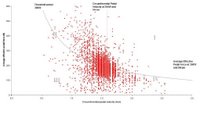I felt that the Marietta race was pretty hard and one of the reason was I was off the front with a couple of very strong riders behind that were not going to let up in catching me. That is pretty good motivation to keep going all out.
But, the Marietta course is not flat and did offer places to recover and two significant climbs, one a run and one a ride. The run up was not reflected in the power data, but I can analyze the rest of the race and see how hard I really rode.
My functional threshold power (FTP) right now is 300W. I have not done a critical power test in awhile and without zeros included in the data of the last few races, my FTP has been consistant at that value.
If I look at the data from that race, my power numbers (with zero) show that I am 57% below 300W for the 47 minutes. If I take out the zeros and only consider pedaling power (more accurate of 'cross) I find that I am 50% at or above FTP and 50% below FTP. The mode calculation of the data without zeros indicates the most frequent power value to be 336W.
Most of the zero values come from the downhill part of the course and from cornering, gliding into run-ups, and other changes of pace. Being out on my own with no one to draft, 7% without pedalling is about what might be expected.
I did a quadrant analysis of the race using 300W as the threshold power and 88rpm as my threshold cadence. I did one with (red) and without (black) zeros.
In quadrant analysis,
Q1=high force and high velocity. At the extreme, this would represented by sprinting, but most any extended supra-threshold effort on level ground (e.g., attack or bridge attempt during a race) would entail "quadrant I pedaling".
Q2=high force but low velocity. Typically, "quadrant II pedaling" occurs when climbing or accelerating, especially from a low speed.
Q3=low force and low velocity. Rides that entail a very large percentage of pedaling that falls into "quadrant III" would typically be those used for recovery or for social purposes (e.g., coffee shop rides), or for recovery in a race after an attack or sitting in.
Q4=low force but high velocity. Racing may also involve a significant amount of such low force, high velocity pedaling, especially during events in which there is a frequent need to accelerate rapidly (e.g., criteriums).
(Coggan, Andrew, 2005. http://www.cyclingpeakssoftware.com/power411/quad.asp)
Applied to cyclocross, besides accelerations after dismount, much of the power applied is similar to a criterium. I am surprised to see so many power values in Q3 in the non-zero graph considering I had no place to sit in or draft. However, there are many places in a 'cross race where easy pedaling is needed right before a dismount, turn or run-up where you are still pedaling but not applying too much power. It could also reflect the first two laps when most of us were together and drafting may have occured.

Power has been described by Coggan as "stochastic" meaning that rarely does power act like heart rate in that there is an extreme amount of fluctuation due to both physiological and environmental reasons. In cyclocross, there are a lot of pace changes and many ways that power can be applied during the race so the stochastic nature of power is really displayed.
I have had the power meter running in most races but I have only used it twice in the races for pacing. In Conyers I used it across the large parade ground grass field, looking back each lap to see my distance away from my persuers and I was able to use the power meter to keep a steady power so I could maintain that split each lap. At Marietta, my weak point has always been the long straight paved section so I used the power meter there to make sure I did not slack off and recover on that section but instead I tried to keep my power consistant at 300W so the more powerful road guys would not make up ground.
There is no safe way to use the monitor all the time in cyclocross and of course it takes away from the experience of racing to be looking at the data output every other second.



No comments:
Post a Comment